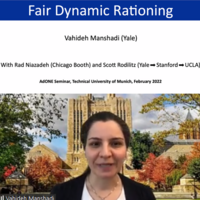We study the allocative challenges that governmental and nonprofit organizations face when tasked with equitable and efficient rationing of a social good among agents whose needs (demands) realize sequentially and are possibly correlated. As one example, early in the COVID-19 pandemic, the Federal Emergency Management Agency faced overwhelming, temporally scattered, a priori uncertain, and correlated demands for medical supplies from different states. To better achieve their dual aims of equity and efficiency in such contexts, social planners intend to maximize the minimum fill rate across agents, where each agent's fill rate must be irrevocably decided upon its arrival. For an arbitrarily correlated sequence of demands, we establish upper bounds on both the expected minimum fill rate (ex-post fairness) and the minimum expected fill rate (ex-ante fairness) achievable by any policy. Our bounds are parameterized by the number of agents and the expected demand-to-supply ratio, and they shed light on the limits of attaining equity in dynamic rationing. Further, we show that for any set of parameters, a simple adaptive policy of projected proportional allocation achieves the best possible fairness guarantee, ex post as well as ex ante. Our policy is transparent and easy to implement, as it does not rely on distributional information beyond the first conditional moments. Despite its simplicity, we demonstrate that this policy provides significant improvement over the class of non-adaptive target-fill-rate policies by characterizing the performance of the optimal such policy, which relies on full distributional knowledge. We obtain the performance guarantees of (i) our proposed adaptive policy by inductively designing lower-bound functions on its corresponding value-to-go, and (ii) the optimal target-fill-rate policy by establishing an intriguing connection to a monopoly-pricing optimization problem. Further, we extend our results to considering alternative objective functions and to rationing multiple types of resources. We complement our theoretical developments with a numerical study motivated by the rationing of COVID-19 medical supplies based on a projected-demand model used by the White House. In such a setting, our simple adaptive policy significantly outperforms its theoretical guarantee as well as the optimal target-fill-rate policy.
Skip to content
Menu
Google Custom Search
Wir verwenden Google für unsere Suche. Mit Klick auf „Suche aktivieren“ aktivieren Sie das Suchfeld und akzeptieren die Nutzungsbedingungen.
